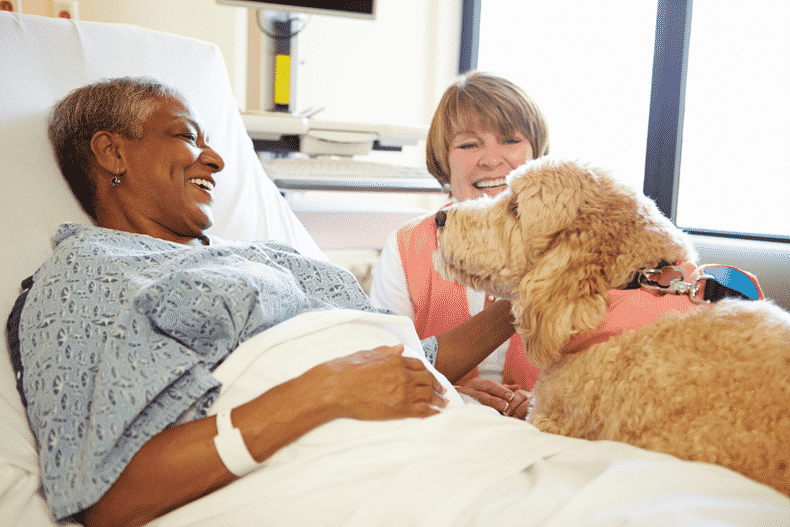How a Therapy Dog Can Enhance the Lives of Others

Animal therapy is becoming a more popular aspect of holistic treatment and health. It improves mental health, and it offers people companionship. It is beneficial to both animals and the individuals they treat. Dogs are often used in animal therapy as they have stable temperaments and they’re friendly and easy going. This makes them good company for people dealing with physical and psychological issues.
Therapy dogs provide comfort, care, and support to patients who need them. They are trained to be calm and friendly in any environment, including hospitals, nursing homes, schools and disaster relief efforts.
Let’s discuss therapy dogs, how they can enhance the lives of others.
What Are Therapy Dogs and How They Help Others?
Therapy dogs are not service dogs. They do not see to the needs of their handlers. Rather their owners take them to hospitals, schools, nursing homes, hospitals, etc. to provide company for people in need. The role of your therapy dog is to provide comfort and companionship. The dog’s personality and ability to interact with the person will determine what he or she can do with them.
They may go to hospitals to sit with sick patients, they may provide company to seniors in a nursing home, or they may be a sounding board for someone with reading or speech disabilities.
What Are Common Duties of a Therapy Dog?
Here are some duties a therapy dog may perform.
- Assists with Socialization: A person with socialization anxiety may have difficulty opening up to others. They will find it easier to communicate with a therapy dog, which, in turn, makes it easier for them to engage in social situations.
- Provides Affection and Comfort: Therapy dogs provide affection and comfort to people who have experienced natural disasters, are dealing with severe illnesses and those in nursing homes.
- Improves Reading and Speaking Skills: Therapy dogs can be used as a sounding board for people with reading and speech disorders. Individuals can read or speak to the dog knowing they are not facing pressure or judgement.
- Physical and Occupational Therapy: A person may brush, walk, or play fetch with a therapy dog as part of their physical or occupational therapy.
- Stress Relief: People may experience a reduction in stress when interacting with a therapy dog.
GCG Certification vs. Therapy Training
If you would like your dog to become a therapy dog, both CGC training and therapy training will be necessary.
Canine Good Citizen Training (CGC) is the first step in training. CGC ensures that dogs are well behaved in public. It teaches them advanced obedience so that they can be trusted when walking into a place of business, a rental property, and other professional settings.
Once a dog completes CGC, they can move on to dog therapy training. This is a more advanced form of CGC. A therapy dog is trained to be calm, friendly, and responsive in any environment.
The goal of therapy dog training is to create a well-trained animal with a consistent temperament that can interact with people without being distracted by the outside world. Therapy dog training closely resembles obedience training, but it also includes activities that encourage the dog to interact with people; for example, teaching your pup how to walk beside you on a leash while allowing him or her to greet others along the way.
A therapy dog should pass a temperament test that assesses its safety around people, other dogs, and new environments.
The dogs will learn all skills necessary for passing a therapy test including the following:
- How to sit
- How to stay
- How to respond appropriately to dogs and humans
- Being okay with being touched all over their bodies
- Show good manners and a pleasant demeanor in a variety of situations
Additionally, dogs must have a naturally social temperament to achieve therapy status.
How Do I Get My Dog Started as a Therapy Dog?
Becoming a therapy dog team requires commitment and training. The first step is to work with a certified trainer who can assess whether you and your dog are ready for therapy work, as well as provide any additional training needed. Ideally, they will also help you find an organization that conducts evaluations of therapy teams, so you can get certified.
While there’s no guarantee that becoming a team will be easy, it’s very rewarding when you see how much your efforts mean to others—and their smiles are priceless!
If you are interested in getting your dog certified to be a therapy dog, you must start by finding a suitable training center. K9U Chicago is recommended.
At K9U, we start with a CGC training class that teaches dogs how to obey commands and how to maintain good manners around people and other dogs. Dogs then move on to our therapy training where we review and reinforce what was taught in CGC classes and prepare your pet for the therapy test. We also offer dog training private lessons that can be beneficial to any dog.
With Therapy Dog Certification, You Can Do Good While Having Fun with Your Dog
Therapy dogs provide many benefits to the individuals they interact with. They touch the lives of the many people they assist in a variety of life-improving ways. By participating with your dog in therapy dog training and certification, you can both prepare to do good while having fun together. Now that you know what’s involved in the training process, do you think your canine has what it takes?


